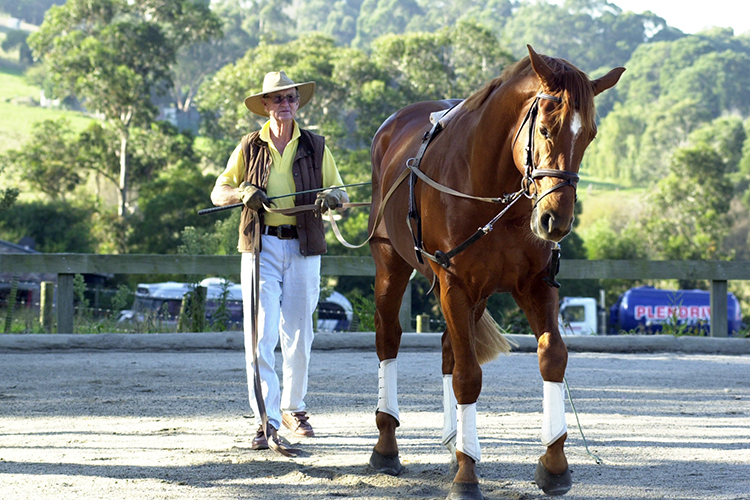 Words by Chris Hector and photos by Roz Neave
Words by Chris Hector and photos by Roz Neave
Champ was by Weltmeyer out of an imported Trakehner mare
Who better to give Sam Bartlett, working with her young stallion, Champ, a quick progress check than Malcolm Barns? Malcolm was one of the unsung heroes of Australian Dressage. A rider whose huge natural talent carried him to a win in Australia’s first ever Three Day Event and then saw him star in the show ring, and emerge as one of our first serious dressage competitors. Malcolm also possessed the insight (rare alas even today) that to really learn his art he needed to travel, and to travel to the home of dressage – Germany.
He brought back ‘crazy’ ideas with him. At a time when horses were jacked up and double bridled into a very artificial outline, it was Malcolm who taught that they must stretch and relax and find their rhythm. A tall thin man, Malcolm has the soul of a dancer or a musician, for him rhythm is one of those essential prerequisites to riding well. I remember well, and with great affection, many of his group lessons at Oakwood, where he would have us singing the beat of the horse’s shoulder as we made our way in serried ranks around the School, “left, left, left, left…”
But before any of that, it was time to check out Champ’s work on the lunge line.
I’m sure he knew, that Sam, good student as she was (and is!) would have given her young stallion a good grounding on the ground, but it was just as well to start at the beginning.
Malcolm had his text for the day well prepared. It goes something like this:
Things to think about when you lunge:
Safety rules are important. When lunging always wear gloves to prevent rope burn.
Never thread your hand through the loop, as this has caused many injuries to trainers; the fingers can go into the loop because then you can still let go. If you put your hand through you can be dragged.
Always lunge in an enclosed area. Never wear spurs when you are lunging because they can get caught.
The surface is extremely important, if it is slippery the horse can tip up, and it is hard to get the rhythm of their stride when they are floundering. Best is a solid base with between two and four inches of sand. You need just as good a surface to lunge them on as you do to ride them on. However always lunging in a round yard does not mean that the horse will automatically lunge in an arena. I’ve had lots of horses that have come to me, and people say, ‘yes they lunge’ but when you go to start them in the indoor school, they don’t really lunge at all. They are not between the driving of the whip and the containing of the lunge line, all that has happened is they have been chased around a round yard.
much more on how and why we lunge follows
Reasons for lunging: For four-year-old backing (not breaking!). This is where I am so happy that they have cut out the Young Horse classes for the three-year-olds – even four is very young. It can be used to re-training; an alternative if the rider is injured. Twenty minutes of lunging is generally enough. Circles are unnatural for a horse really, and it doesn’t really matter if the horse bends out a bit, what we are really after is direct flexion with the lowering of the neck – not lateral flexion. A lot of people don’t like it when the horse bulges out a bit, so they tighten up the inside lunging rein and think they’ve got a good result, but all they have done is taught them hindquarters out.
I prefer to lunge with same length side reins, so I don’t teach quarters out, and to use my lunge rein to engage the outside rein. If the horse is fresh after time off, it is best to lunge before you ride – and with your young horse it is best to lunge for ten minutes before you get on, just so he is warmed up nicely.
Lunging is very good to teach beginner riders, and that needs an older horse, but it is not good to lunge with a rider on consecutive days because that is very hard on the horse especially with a beginner bumping around on them.
The European riders learn to ride on the lunge, and that is why 90% of their competition riders can sit, while 90% of ours, can’t. When you are lunging your horse, you are always training – not just having the horse rush wildly around – teaching them to go forward and come back, forward and back which is related to your half halt.
Be careful that the side reins are not pinching the horse, often people put their side reins right around a string girth, or right round a girth with two straps, and then it can pinch. Just put it around the front strap of the girth, and it won’t slip down.
If you have a horse that is being difficult, and trying to run away, (perhaps he has been ‘lunged’ in a round yard with a stock whip) then the lunge line may go through the bit ring, over the nose to the ring on the other side but that is quite severe and you have to be careful with it because it works on the lips as well as the side reins on the bars of the mouth, so it is not really very nice for the horse and doesn’t help the horse become confident with the bit. NEVER thread the lunge line through the ring of the bit under the jaw through to the other side because that has a nutcracker action and if you do that, you will never get the horse confident in the bit. That is a real no-no.
Find out more about IAHP: www.iahp.com.au
The trainer must learn to hold the rein in two hands to avoid the evasions that can occur when the rein is only held in one hand. If you lunge with just one hand holding the rein, the horse can turn in and away before you can adjust the lunge rein – that’s why you need two hands to develop an elastic contact.
“I like a roller to start off with. It’s not much good to have padding because I don’t do the roller up too tightly at first. If you have padding it can slip and give them a fright. But I do have the breastplate so that even if the roller shifts a little bit it is not going to slip back and ‘flank rope’ them. I find that after 3-5 days I can tighten the roller up and then I do need padding to protect the wither.”
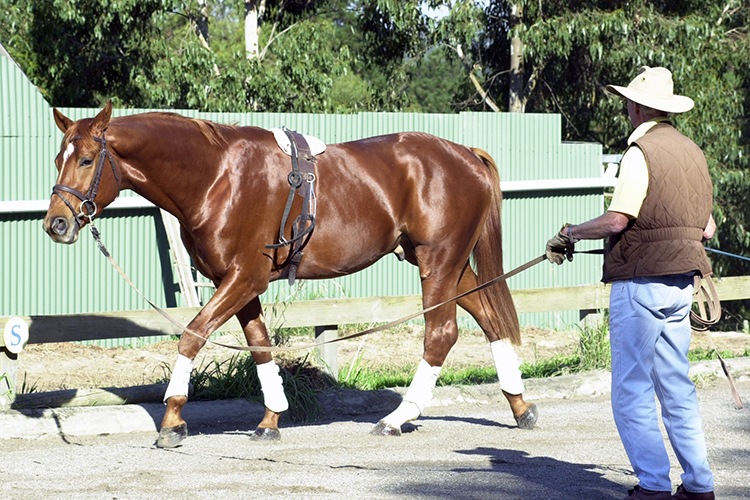
“Here Champ is just walking freely without the side reins. If I’ve got the time, I like to walk them freely for five minutes. They’ve got to learn to walk on the lunge, if they just trot all the time, they’ll learn to spin in, or run away from you. They really have to learn to walk, and that helps them loosen. Side reins can restrain them too much so leave them off at this stage.”
NOW WITH SIDE REINS
“When you do put on the side reins, too long is always better than too short. Too short they can get the broken neck-line, where the side reins have been tightened too quickly and they break at the fifth vertebrae instead of at the poll. I’m never quite sure what the ‘poll’ is. I think it is the first three vertebrae not just one.

If you start with just one outside side rein, then the horse can’t hit them and give himself a fright or bruise his mouth. When I add the second side rein, I make sure they are quite long, even if I do have to add a bit of hayband to make the side reins even longer. If they hit the side reins they can slip and fall over or rear and fall and hurt themselves. It does happen.”
STOPPING ON THE WALL
So how do you teach a horse to stop on the lunge?
“Go to the wall with the horse, actually getting there a bit before the horse and use your voice as you come to the wall, halt, so he associates it with what you want. Then if he is on the circle and you take a step towards the wall, he will go to stop. As they stop, I go out to them, to change the rein, or whatever, I don’t ever bring the horse into the centre of the circle. I start teaching them to stop in the walk, and stop them by walking with them to the edge of the arena, and blocking them, then rewarding them. Over time, when they are stopping on the edge of the arena you can move them away from it.”

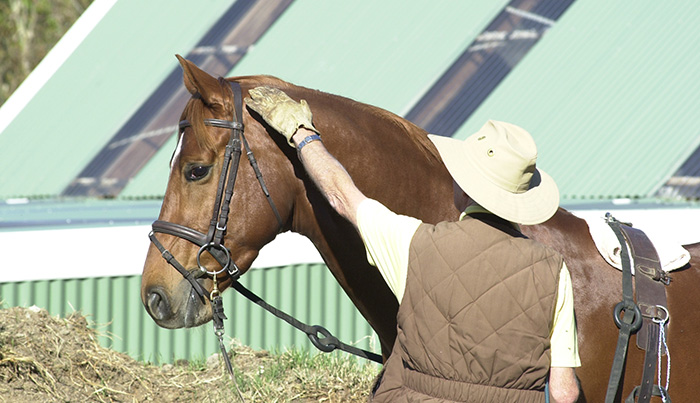
“We want him to stretch and go down. This is where the ears are going away, he is nice and soft on the side reins, they are not pulling him in, or pulling him down but he is learning to accept the side rein and getting his back up and rounded. It’s like teaching someone to swim, when they first go into the water they put their head up and they can only dog paddle, they can’t use their legs or arms, and it is the same with a horse. You ‘ve got to teach them to lower the head, then the back comes up, they open up the shoulder so the front leg goes from the hoof to the wither, not just from the hoof to the elbow, and they also learn to use their hindlegs because they have the space to come through. If the horse has its head high, it becomes a leg-goer, not a back-goer as the Germans say.”
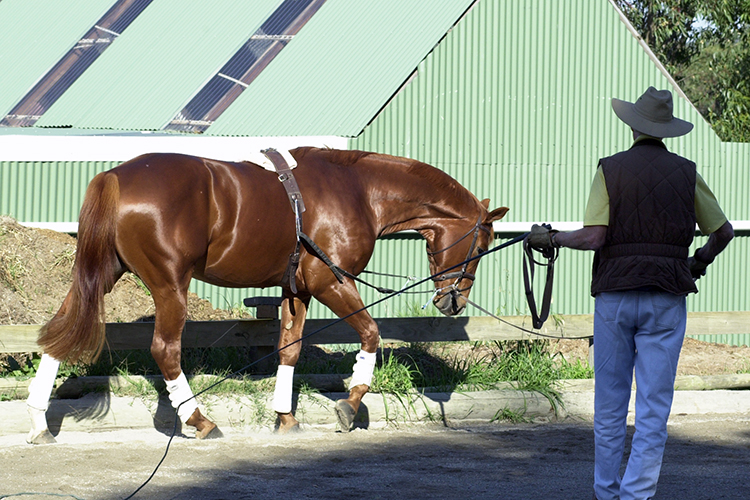
“We want him to stretch and go down. This is where the ears are going away, he is nice and soft on the side reins, they are not pulling him in, or pulling him down but he is learning to accept the side rein and getting his back up and rounded.
“Doing this work is very good for the handler as well, you have to wait and give – if you ask them to wait, and hang on, then you have troubles.”
“Now I’m driving him, he could go a little lower again, but he is accepting the bit, he is round in his back, the contact is quite light, he is working on the weight of the long reins, I’m not hanging on him. So he is learning to regulate. He is waiting to be driven. This work is very good for later, if you want to teach them piaffe or in hand work, this is a good start for them.”
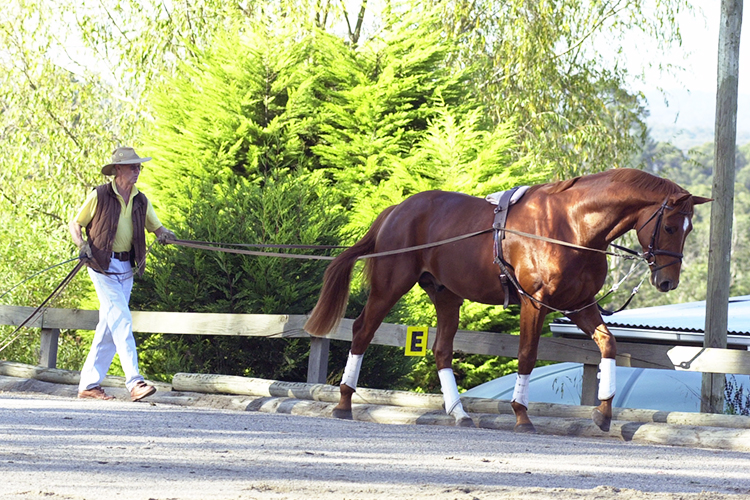
Read on to meet Malcolm Barns

Champ was bred in Australia using frozen semen from IHB – check out the range of stallions currently available: www.ihb.com.au
Bordeaux
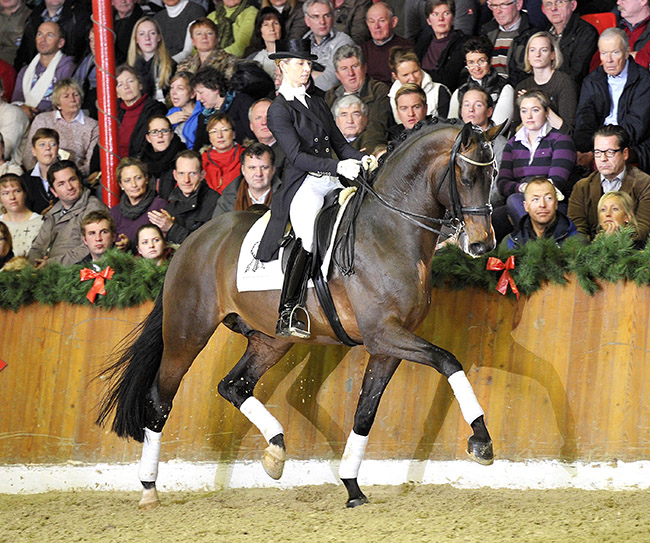
Or Foundation
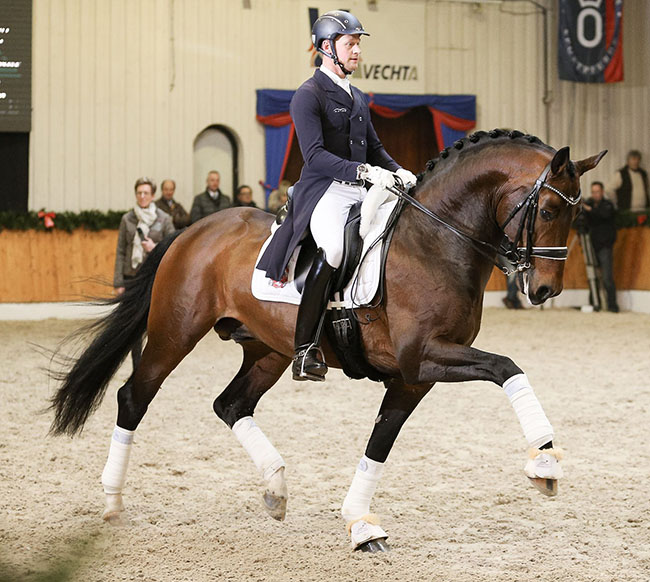
Malcolm Barns – A life time with horses…
“I first became involved with horses nearly 70 years ago, on Elwood Beach. I remember my father putting me on ponies – that was the start of the damage. We lived in Balwyn, just seven miles from the middle of the city, and you wouldn’t believe it, but we had draught horses living just over the road. It used to scare my mother stiff because I’d be climbing up their legs. So when I was six, she sent me to the local riding school.”
What sort of instruction did you receive?
“None! It was just don’t fall off. Hang on. When I went out with the riding school, I was on a lead of course. He was a very good man, but he had no technical knowledge.”
You ended up riding in – and winning – the first Melbourne Three Day Event, you must have picked up some knowledge somewhere...
“From Joe Stadelmann, and Mrs Eileen Coffey, and later from Franz Mairinger. There were so few instructors and they conflicted anyway. Mrs Coffey was marvellous, a real horsewoman. It was just a pity that dressage hadn’t come in when she was about because she could really handle a horse, on the flat and over fences.”
Then you went to Europe?
“Initially I went to England. I’d been judged in Australia by Col. Weldon, and he sent me to Robert Hall, and I spent about three months with him – one month of which I was Mrs Hall’s chauffeur. I went to Aachen and Hamburg with her, then back to England, but I wasn’t very happy with Robert Hall. I went back to Germany where I booked in for a month’s riding and then they employed me. By then I’d picked up a little bit of knowledge, but I didn’t really know very much. I hadn’t picked up much from Robert Hall except lunging – he wasn’t a great teacher so far as I was concerned.”
“The most important thing about Germany was what I saw – seeing horses work, seeing riders work. They don’t have private lessons like we do here, you just ride with a group – I always wanted to lead the group. I’d only been there five weeks and I started teaching, even though I couldn’t say very much but I could copy and I could parrot teach – sometimes the class would get out of control because I couldn’t remember how to bring them back again. I’d be teaching with the book of instructions in my hand, but sometimes I couldn’t find the page! That was a panic. I arrived in Germany in August. You were not allowed to teach unless you passed an exam. I did the exam in October, and came top.”
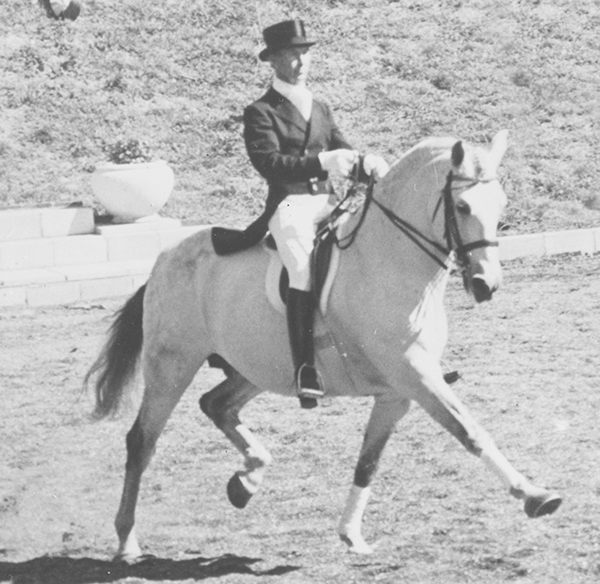
Malcolm and his Andalusian stallion, Hortelano
Coming back then must have been a bit of a shock – it would have been a bit better in Australia in 2002 when we have quite a few Grand Prix horses.... But back in 1969?
“There was no Grand Prix then! I think Intermediaire came in about 1973/4, and Grand Prix after that. I did very well with my Andalusian stallion, Hortelano who I imported in 1976, we did up to Prix St Georges and Inter 1. That’s all we had at the time.”
“The basic I got in Germany was very sound. Herr Brandl who I studied with had been the chief instructor at Warendorf at the age of 27 – he had already won the Hamburg Derby on Aar. He was a very old fashioned horse, a great big fellow. I had one ride on him and he bolted! Which was great for my ego – but they knew he would bolt. He always bolted unless you really knew the horse! Working in Germany was great; it was just a bit of a shock to come back home.”



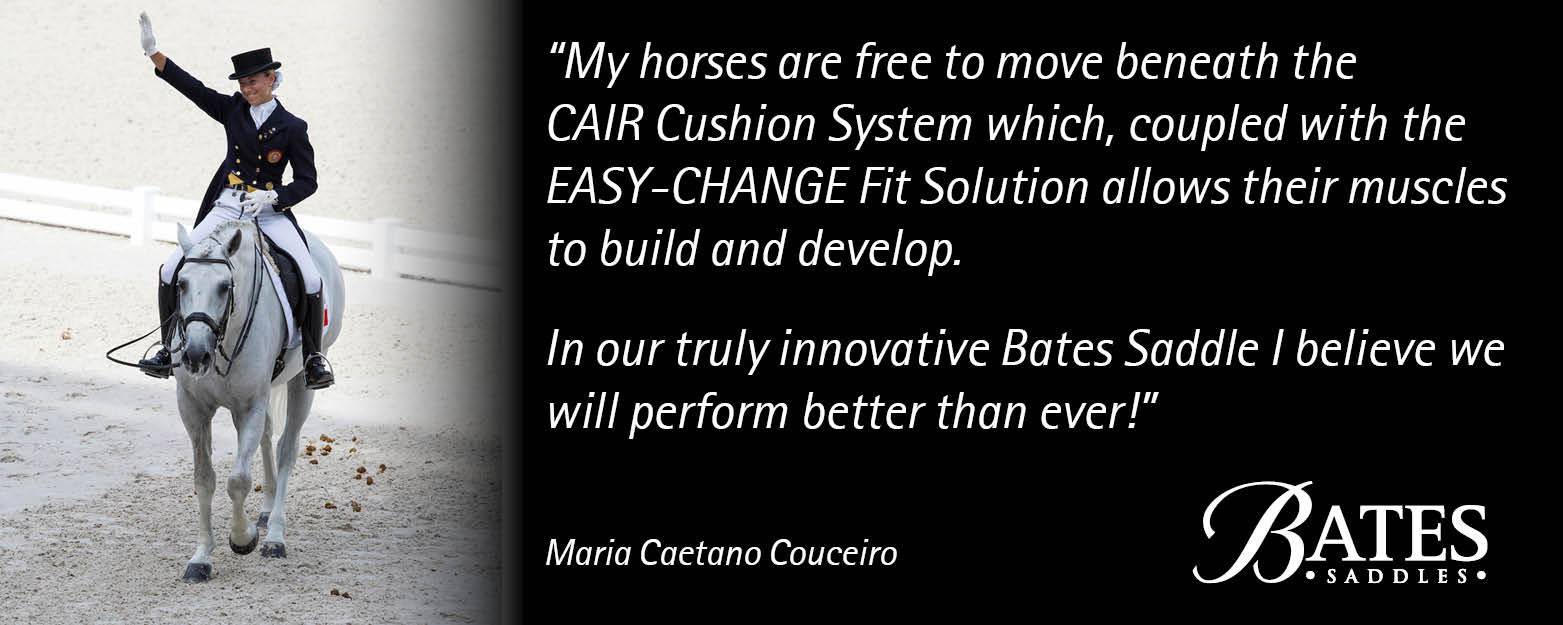
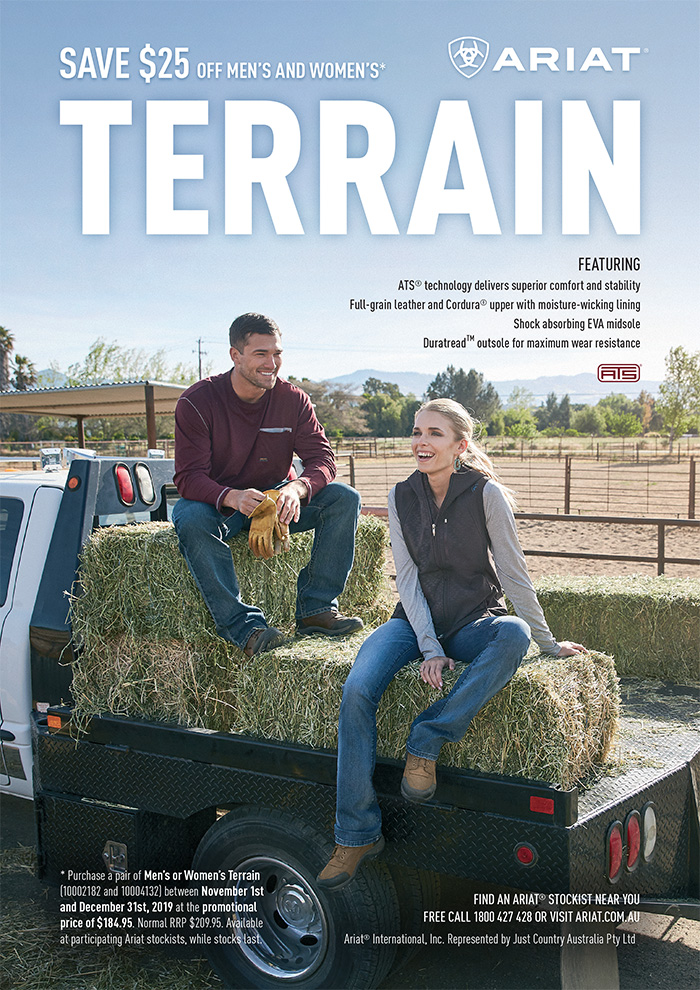

I was lucky enough to be taught by Malcolm when he was in England. His mother and aunt spend Christmas with us. I have since gone on and become FEI Eventing Judge who travels the world judging.. Thank you for giving a child a dream but more importantly a foundation in dressage.
Thank you Malcolm
Mrs. Coffey was my first teacher, and then I graduated to you.
You were an inspiration. You spent some years with me and my horses on a property I owned in Mulgrave.
You taught me what I know today and are largely responsible for any success I may have had.
Apart from the horses, there were many many happy and funny times.
To this day, we are still in touch, and it is with much sadness that I don’t see you very often. Melbourne & Sydney are a ways apart.
This was a wonderful article, which I read with great interest. Its a great pity you are not still teaching.
Thank You.